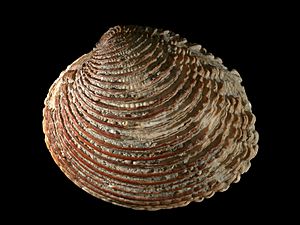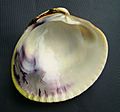Veneridae facts for kids
Quick facts for kids Veneridae |
|
|---|---|
 |
|
| A valve of Venus verrucosa | |
| Scientific classification |
|
| Kingdom: | Animalia |
| Phylum: | Mollusca |
| Class: | Bivalvia |
| Subclass: | Heterodonta |
| Order: | Veneroida |
| Superfamily: | Veneroidea |
| Family: | Veneridae Rafinesque, 1815 |
| Genera | |
|
See text |
|
Veneridae is a large group of clams, often called Venus clams. There are more than 500 different kinds, or species, of these clams. They are a type of bivalve mollusc, which means they have two shells that are hinged together. Many Venus clams are safe to eat and are enjoyed as seafood around the world.
Contents
What Are Venus Clams?
Venus clams are part of a big family of sea creatures. They are known for their strong, often pretty shells. These shells protect the soft body of the clam inside. Clams are invertebrates, meaning they don't have a backbone. They are related to snails and octopuses.
Where Do Venus Clams Live?
You can find Venus clams in almost every sea on Earth. They prefer to live near the shore, especially in places with sandy bottoms. They often bury themselves in the sand or mud. This helps them stay safe from predators and strong ocean currents.
What Do Venus Clams Eat?
Venus clams are filter feeders. This means they get their food by filtering tiny bits of food from the water. They use a special tube called a siphon to draw water in. Then, they filter out small particles like plankton and other organic matter. Another siphon pushes the clean water back out. This process helps keep the ocean water clean.
How Do Venus Clams Grow?
Like many other bivalves, Venus clams start their lives as tiny larvae. These larvae float in the ocean water. As they grow, they develop shells and settle down onto the seabed. They then grow into adult clams. Their shells grow bigger and stronger over time. The rings on a clam's shell can sometimes tell you how old it is.
Different Kinds of Venus Clams
Because there are over 500 species, Venus clams come in many shapes, sizes, and colors. Some are small, while others can be quite large. Their shells can be smooth, ridged, or even spiky. Each type of Venus clam has its own unique features. Some common examples include the hard clam and the carpet shell clam.
Images for kids
-
Venerid bivalve from the Late Cretaceous period, near Amman, Jordan
-
Irus elegans from New Zealand
-
Pitar lupanaria from Costa Rica
 In Spanish: Venéridos para niños
In Spanish: Venéridos para niños










